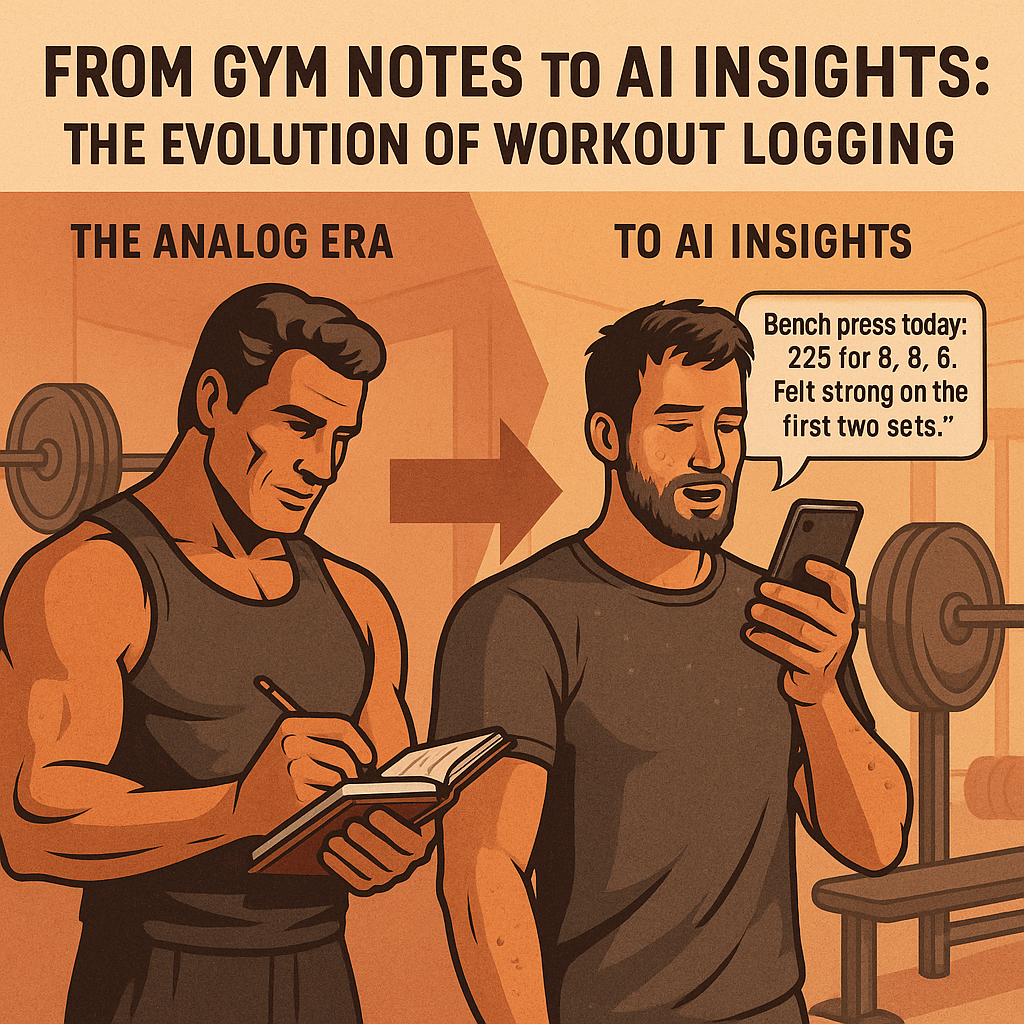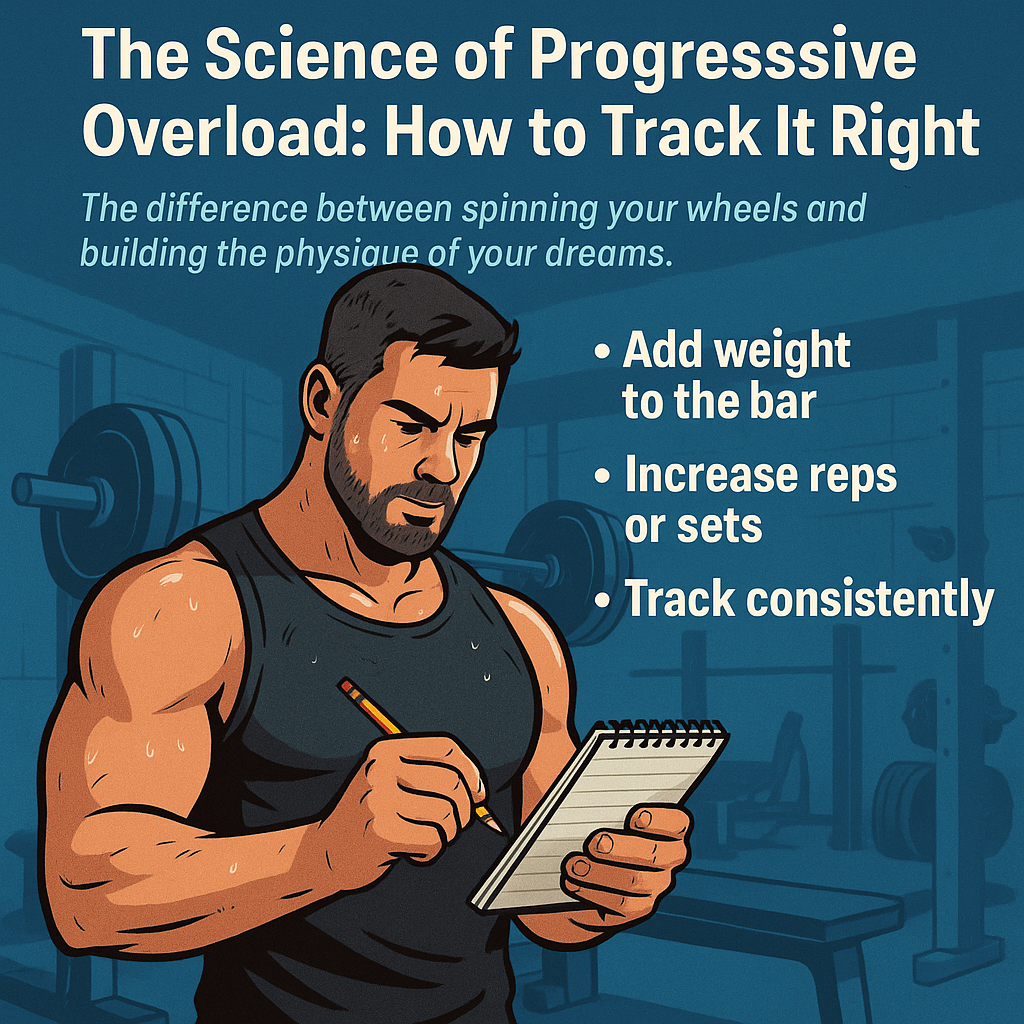From Gym Notes to AI Insights: The Evolution of Workout Logging
A journey through time—from pencil and paper to AI-powered insights that revolutionize how we understand our bodies.
In 1970, Arnold Schwarzenegger kept a leather-bound notebook. Every rep, every set, every weight—meticulously handwritten between sets in the original Gold's Gym. That notebook became the blueprint for a seven-time Mr. Olympia champion.
Fast forward to 2024: Athletes carry supercomputers in their pockets, yet 80% still struggle with the same problem Arnold solved with a 99-cent notebook.
Consistent, meaningful workout tracking.
Chapter 1: The Analog Era (1960s-1990s)
The Pioneer Method: Pen & Paper
Before apps, before smartphones, before the internet—there was paper. And it worked.
The Original System:
- •Composition notebooks from the drug store
- •Golf pencils (they don't break)
- •Simple columns: Exercise | Weight | Reps | Notes
- •Calendar pages for workout dates
Why It Worked:
- •Zero friction: Grab pencil, write numbers
- •No distractions: Just you, your workout, and the data
- •Personal: Your handwriting, your system, your progress story
- •Reliable: Never crashed, never needed updates
The Heroes of This Era:
- •Arnold Schwarzenegger: Used detailed logs to plan every workout phase
- •Louie Simmons: Built Westside Barbell's conjugate method on meticulous data tracking
- •Dorian Yates: Tracked intensity and volume to optimize his high-intensity training
The Problems:
- •Lost notebooks = lost progress (weeks of data gone forever)
- •No pattern analysis (trends hidden in pages of numbers)
- •Hard to share (couldn't compare with training partners)
- •Illegible writing after intense sessions
Chapter 2: The Digital Dawn (1990s-2000s)
Spreadsheet Revolution
Microsoft Excel changed everything. Suddenly, your workout data could:
- •Calculate automatically (total volume, 1RM estimates)
- •Graph progress (visual trend lines)
- •Store indefinitely (backup copies)
- •Analyze patterns (which exercises were progressing?)
The Excel Power Users:
These athletes built sophisticated tracking systems:
- •Multiple sheets for different training phases
- •Formulas for progressive overload calculations
- •Charts showing month-over-month trends
- •Complex macros for advanced analytics
Popular Templates:
- •Starting Strength spreadsheets
- •5/3/1 calculators
- •Sheiko program trackers
- •Custom powerlifting meet prep sheets
Early Web-Based Tools
Sites like Jefit and FitNotes emerged, offering:
- •Cloud storage (access anywhere)
- •Exercise databases (no more typos)
- •Basic social features (share workouts)
- •Mobile-friendly interfaces
Chapter 3: The Smartphone Era (2007-2015)
The App Explosion
The iPhone launched in 2007. Within five years, the App Store had 50+ fitness tracking apps.
Game Changers:
- •Strong: Clean interface, excellent for powerlifting
- •Jefit: Massive exercise database, social features
- •FitBod: AI-powered workout generation
- •Strava: Social fitness tracking (mainly running/cycling)
What Apps Solved:
- •Always with you: Phone in pocket = logger in pocket
- •Faster input: Tap to select exercises, swipe to add weight
- •Built-in intelligence: Rest timers, progression suggestions
- •Community: Share workouts, compare with friends
What They Didn't Solve:
- •Still required attention: Multiple taps per set
- •Workflow interruption: Pull out phone, unlock, navigate, input
- •Complexity creep: Too many features, confusing interfaces
- •One-size-fits-all: Generic programs, not personalized insights
Chapter 4: The Wearable Wave (2012-2020)
The Quantified Self Movement
Fitbit, Apple Watch, and Garmin promised to track everything automatically:
- •Steps, heart rate, calories burned
- •Sleep quality, recovery metrics
- •GPS tracking for outdoor workouts
- •24/7 health monitoring
The Reality Check:
Wearables excelled at cardio but struggled with strength training:
- •Can't distinguish exercises: "Workout" vs specific movements
- •Poor rep counting: Wrist sensors miss many strength movements
- •No weight tracking: Can't detect how much you're lifting
- •Generic insights: Population averages, not personal patterns
The Hybrid Approach:
Smart athletes combined tools:
- •Wearables for cardio and recovery data
- •Traditional apps for strength training details
- •Spreadsheets for long-term analysis
- •Paper notebooks as backup systems
Chapter 5: The AI Revolution (2020-Present)
The Context Problem
Despite decades of innovation, a fundamental problem remained: The gap between workout execution and data capture.
Every existing solution required you to:
1. Stop your workout
2. Navigate an interface
3. Input structured data
4. Resume training
This friction killed consistency.
Enter Natural Language Processing
2020 brought a breakthrough: AI systems that could understand fitness language.
Instead of:
*Tap "Bench Press" → Enter "225" → Select "lbs" → Input "8" reps → Tap "Add Set" → Repeat 2 more times*
You could simply say:
*"Bench press today: 225 for 8, 8, 6. Felt strong on the first two sets."*
The AI automatically captures:
- •Exercise: Bench Press ✅
- •Weight: 225 lbs ✅
- •Sets: 3 ✅
- •Reps: 8, 8, 6 ✅
- •RPE: ~7-8 (inferred from "felt strong") ✅
- •Notes: Performance variation across sets ✅
What's Available Now vs. What's Coming
✅ Currently in W8Log:
- •Voice-powered exercise recognition
- •Automatic set and rep parsing
- •Natural language workout logging
- •Basic progress tracking and analytics
🚧 In Active Development:
Our team is building the next generation of intelligent fitness tracking:
Advanced AI Analysis:
- •"Your squat typically stalls at week 6—consider a deload"
- •"Bench responds best to 4-6 rep ranges for you"
- •"You're 15% stronger on Tuesday vs Friday sessions"
Smart Watch Integration:
Soon you'll speak directly to your watch during workouts:
*"Apple Watch, log overhead press: 135 for 8, feeling good."*
Your watch will capture:
- •Exercise details from voice ✅
- •Heart rate during sets ✅
- •Calories burned ✅
- •Rest periods automatically ✅
- •Recovery metrics ✅
- •Complete workout physiological profile ✅
AI-Powered Program Generation:
Our AI will analyze your entire training history to create personalized programs:
"Based on your last 12 weeks, I've designed your next program focusing on strengthening your weaker posterior chain while maintaining your pressing strength. Here's why this approach will accelerate your progress..."
The AI will explain:
- •Weak points identified from movement patterns
- •Muscle imbalances detected in your data
- •Optimal training frequency for your recovery
- •Progressive overload strategy tailored to your response
- •Periodization plan for long-term gains
Chapter 6: The Future (2025 and Beyond)
The Convergence
We're seeing the best of all eras combine:
From Paper Era:
- •Simplicity and reliability
- •Personal, distraction-free logging
- •Focus on essential data
From Digital Era:
- •Automatic calculations and analysis
- •Long-term data storage and trends
- •Advanced programming insights
From Modern AI:
- •Natural, conversational input
- •Intelligent pattern recognition
- •Personalized coaching recommendations
The W8Log Vision: Complete Training Intelligence
🔮 Coming Soon:
Seamless Wearable Integration:
- •Direct voice commands to Apple Watch, Garmin, and other smartwatches
- •Automatic correlation of exercise data with biometric markers
- •Real-time form feedback based on movement sensors
- •Heart rate variability training recommendations
Predictive AI Coaching:
- •Programs that adapt daily based on your recovery state
- •Exercise selection optimized for your strength curve
- •Injury prevention alerts before problems develop
- •Competition prep periodization with precision timing
Holistic Health Integration:
- •Sleep quality impact on training performance
- •Nutrition timing recommendations for optimal recovery
- •Stress level adjustments to training volume
- •Complete lifestyle optimization for athletic performance
Computer Vision Training:
- •Cameras that automatically count reps and assess form
- •Real-time biomechanical feedback during exercises
- •Automatic weight detection from plates loaded
- •Movement quality scoring and improvement suggestions
The Ultimate Training Ecosystem
Imagine walking into your gym and saying:
"Hey W8Log, I slept 6 hours last night and my stress is high. What should I train today?"
Your AI responds:
"Based on your recovery metrics, let's focus on upper body strength today. Your shoulders need attention, and your CNS can handle moderate intensity. Here's a customized program that will drive progress without overreaching..."
This isn't science fiction. This is our roadmap, and every feature is in active development.
The Timeless Truth
Across six decades of evolution, one thing hasn't changed:
The best tracking system is the one you actually use.
Arnold's notebook worked because it fit his workflow. Excel spreadsheets worked for analytical athletes. Apps worked for tech-savvy trainers.
Today's AI-powered voice tracking works because it eliminates the friction that killed every previous system.
Tomorrow's integrated ecosystem will work because it disappears entirely—leaving you free to focus purely on performance.
Your Place in History
You're not just choosing a workout tracker—you're participating in the evolution of human performance optimization.
From Arnold's handwritten notes to AI insights that would have seemed like science fiction in 1970, we've come impossibly far.
Yet we're just getting started.
The next chapter is being written by athletes like you, one voice command at a time.
Ready to be part of the next evolution in workout tracking? Download W8Log today and experience the foundation of tomorrow's training intelligence.

